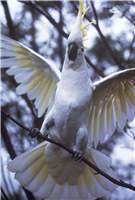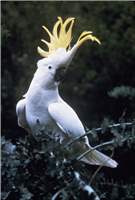Family
Cacatuidae
Genus
Cacatua
Species
galerita
Threats/Control Methods - Regional
Cockatoos can spread the seeds of weed species to adjacent woodland. This species has adapted particularly well to the partial land clearing of the region and does not seem to have problems finding nest hollows, food and water.
Threats/Control Methods - Local
Within the suburbs, Cockatoos are attacked by the smaller but more aggressive Common Mynas (Acridotheres tristis ).
Local/Urban Actions
Suburban gardeners should ensure that yards are free from any seed bearing weed species.
Common Names
Sulphur-crested Cockatoo, White Cockatoo
Distinguishing Features
The Sulphur-crested Cockatoo is a large white parrot 45-50cm in length. It has a distinctive bright yellow crest, yellow feathers on the underside of the wings and tail and a large, wide, dark grey beak. The males, females and young look almost identical. The species is loud and conspicuous both in flight and resting and is common in large eucalypts around Canberra.
Survey Techniques
Call and visual identification.
Species Call
Very loud, some consider unpleasant screeches: 'airrrik, aarrrk, ahrk, aieirrk, aieirieik!'
Similar Species
The Gang-gang Cockatoo (Callocephalon fimbriatum ) and the Yellow-tailed Black-Cockatoo (Calyptorhynchus funereus) are similar in size and shape, however their dark plumage makes them very easy to differentiate.
Distribution
The Sulphur-crested Cockatoo's range extends across Eastern Australia, Tasmania and Northern Australia, with a small population around Perth. They are also found in New Guinea and the Aru Islands and have been introduced into New Zealand and Indonesia.
Country of Origin
Australia.
Conservation (Pet/Pest) Status - Regional
Numbers are highest in autumn and winter with numbers dropping in spring as they retreat to the mountains to breed. Numbers have tripled since 1981 (COG).
Conservation (Pet/Pest) Status - National
Secure, not listed under the EPBC Act 1999. They are listed as an official Native Household Pet Animal. Sulphur-crested Cockatoos are considered a pest in some urban situations, as they can damage wood decking, panelling, and sometimes window and roof eaves.
LSCCES Population
The species was found in high numbers across the entire survey area.
Associated vegetation community
The species is found in a variety of forest environments, from rainforest to woodland and partly cleared farmland. They are also common around suburban and urban areas.
Limiting Resources
Cockatoos require a reliable water source and mature trees for nesting hollows.
Breeding
This species breeds throughout the year in large tree hollows. Both parents incubate two large white eggs for 30 days. The young spend 65 days in nest and are fed by their parents for several months after they have learnt to fly.
Behaviour
The Sulphur-crested Cockatoo is renowned for its noisy calls and confident behaviour. They are loudest as they fly across the suburbs in large flocks towards their communal roosts in tall eucalypt trees around sunset. When breeding, the male cockatoo will display his crest and bob his head.
Functional Group
Food Species
Mainly ground feeders, they spend their time feeding under trees in large flocks. They will eat a variety of seeds, fruits, berries or roots. They are not particularly fussy and survive well in the suburbs. They will eat food provided by humans.
Predators
Although the Sulphur-crested Cockatoos are large and strong, Common Mynas (Acridotheres tristis ) are known to gang-up on and attack them. Mynas compete for nesting hollows and may evict birds and their eggs or young from tree hollows.
Interesting Fact
This is one of the best known species in Australia, common in other countries as a zoo animal and as an exotic pet.
References - (reader suitability of references, P=Primary teachers, S=Secondary students, T=Tertiary students and researchers)
Books:Morcombe, M. 2000. Field Guide to Australian Birds. Steve Parish Publishing. Archerfield. Australia P, S, T
Schodde, R. and Tideman, S. (eds) 1990. Reader's Digest Complete Book of Australian Birds (2nd Edition). Reader's Digest Services Pty Ltd. Sydney. P, S, T
Veerman, P. 2003. Canberra Birds: A report on the first 21 years of the garden bird survey. Philip Veerman and Canberra Ornithologists Group. Canberra. S, T
Internet: Birds in Backyards. 2006. [online]. Available at:http://www.birdsinbackyards.net P, S, T
Canberra Ornithological Group (COG). 2004. Birds of Canberra Gardens. COG and the ACT Department of Urban Services. [online]. Available at:http://garden.canberrabirds.org.au/ P, S, T
Online Publications:Department of the Environment and Heritage. 2002. List of native household pet animals. Australian Government. [online]. Available at: http://www.environment.gov.au/biodiversity/trade-use/lists/pets/index.html
Nix, H. and Cunningham, R. 2006. Birds of the Lower Sullivans Creek Catchment, Canberra ACT. Prepared for the Life in the Suburbs project using data from the Lower Sullivans Creek Catchment Ecological Survey (LSCCES). Australian National University. Canberra. [online]. Available at: http://www.lifeinthesuburbs.com.au/category.php?id=65 S, T
Olsen, P. et al. 2005. The State of Australia's Birds 2006: Invasive Species. Supplement to Wingspan 16:4. Birds Australia. [online]. Available at: http://www.birdsaustralia.com.au/soab/SOAB2006.pdf S, T


 Top
Top Top
Top